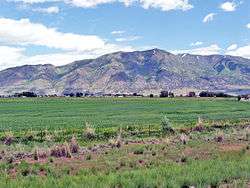Wellsville Mountains
The Wellsville Mountains are located in northern Utah, United States[2] and are often considered part of the Wasatch Mountains.
| Wellsville Mountains | |
|---|---|
 The Wellsville Mountains as seen from the air in mid-September. Box Elder peak and the Wellsville cone are both visible, September 2009. | |
| Highest point | |
| Peak | Box Elder Peak[1] |
| Elevation | 9,372 ft (2,857 m) |
| Coordinates | 41°38′08″N 112°00′52″W |
| Dimensions | |
| Length | 28 mi (45 km) N/S |
| Width | 17 mi (27 km) E/W |
| Area | 307 sq mi (800 km2) |
| Naming | |
| Etymology | Nearby City of Wellsville |
| Geography | |
 Wellsville Mountains Wellsville Mountains  Wellsville Mountains Wellsville Mountains (the United States) | |
| Country | United States |
| State | Utah |
Description
The mountains separate Cache Valley from the Wasatch Front (Bear River Valley), as well as form a portion of the border between Box Elder and Cache counties. Nearly all of the water collected by the Wellsville Mountains drains into the Bear River.[3]
While only moderately tall, they are particularly narrow. For this reason, it is often claimed they are one of the steepest mountain ranges in North America.[4][5][6] Box Elder (9,372 feet [2,857 m]) and the Wellsville Cone (9,356 feet [2,852 m]) are its two highest peaks. US-89/US-91 traverses Box Elder Canyon, Dry Canyon, and Wellsville Canyon, beginning east of Brigham City as a four-lane highway, curving north then northeast and entering Cache Valley at Wellsville.
The mountains were named for the nearby City of Wellsville.[7]
References
- "Box Elder Peak". Peakbagger.com. Retrieved 15 Jan 2013.
- "Wellsville Mountains". Geographic Names Information System. United States Geological Survey.
- "Wellsville Mountains". Peakbagger.com. Retrieved January 13, 2013.
- Wilderness.net, Retrieved 21 Aug 2007
- Bear River Association of Governments, Retrieved 12 Aug 2007
- Publiclands.org, Retrieved 12 Aug 2007
- Van Cott, John W. (1990). Utah Place Names: A Comprehensive Guide to the Origins of Geographic Names: A Compilation. Salt Lake City: University of Utah Press. p. 393. ISBN 978-0-87480-345-7. OCLC 797284427. Retrieved 16 Mar 2018.
